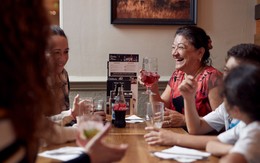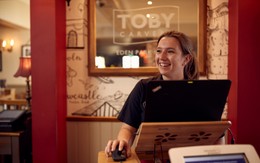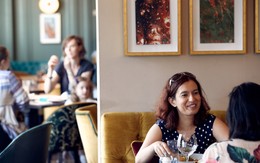The main conclusions from this review are to:
- rapidly reshape Mitchells & Butlers into a food-led business centred around core concepts which have significant growth potential;
- plan a withdrawal from the more price sensitive drinks-led businesses;
- improve our key operating ratios, especially net operating margins;
- improve our return on capital expenditure;
- address the pension funding and reduce net debt to around 5x EBITDA;
- separate the measurement and reporting of the property and operating performance within the business; and
- move the basis of pay and culture towards one which encourages greater growth in shareholder value.
Commenting on the strategy review John Lovering, Chairman, said:
"I am delighted with the cohesion and effectiveness of the new Board which has quickly concluded on a highly attractive growth plan for the business. We are already implementing the plans with targets being cascaded through the business. I am very encouraged by the enthusiasm and commitment of the management and staff and believe that we have all the right ingredients for success."
For further information, please contact:
| Corporate Affairs: Erik Castenskiold | 0121 498 6513 |
| Media: James Murgatroyd (Finsbury Group) | 0207 251 3801 |
There will be a conference call for analysts and investors at 9.30am; please dial +44 (0) 1452 555 566 and quote conf ID 63775146. The replay will be available until 06/04/2010 on +44 (0) 1452 55 00 00, replay access number 63775146#.
Further details on Mitchells & Butlers are available on www.mbplc.com .
The Strategy Review
The Board has conducted a thorough review of the business and has reached the following principal conclusions:
- Mitchells & Butlers' strategy has been well founded. We have gradually increased our food business and have successfully converted high quality, drinks-led pubs to greater food content. The move to food led offers is fully endorsed. The strategy of reducing our exposure to drinks-led pubs has been sound but we believe that it could be progressed faster subject to increasing shareholder value;
- we have previously identified a number of businesses which are not central to our future strategy, but we have only progressed slowly in exiting them;
- the focus has been "estate optimisation" rather than "brand optimisation" with the goal of utilising the existing licensed estate rather than fully exploiting the potential of the brands. As a result there are too many small brands increasing costs and reducing focus;
- we have been cautious in growing outside our historical freehold property base. This has limited brand expansion and insulated us from the disciplines and learnings that flow from the economics of retail locations;
- the management and reporting of the group's retailing and property businesses have been unclear. We will apply a regime of internal rents and differentiated hurdle rates for capital;
- food gross margins have been squeezed by around 4% points in the last three years because we have not recovered product cost increases quickly enough. Our priority over the next period is to improve our cash gross margins;
- good progress in reducing overhead costs has been made but there is still scope for further reductions by removing complexity;
- our review of food buying over the last few months has delivered substantial benefits. We now need to review our goods not for resale and will redesign the non-beer supply chain to our retail outlets;
- we must improve profitability or reduce capital costs if we are to create shareholder value by rolling out our current brands outside our current estate. We have materially reduced the real capital cost of refitting a pub over the last three years, but we aim to take a further 15% from capital cost per square foot;
- concerns about the balance sheet in some external quarters are misplaced. Our financial position is strong and our securitised debt is attractive, secure and has a positive present value to shareholders. Our cash generation and our property intensity make our debt manageable;
- decision making has been overly influenced by earnings per share rather than net present value maximisation. Some divestments which should have been made were rejected for fear of earnings dilution; and
- the senior management compensation schemes have been such that pension entitlements have been more significant than the rewards available from creating shareholder value.
Key strategy headlines
As a result of our review, we have developed our plans grouped around the following themes:
- rapidly reshape Mitchells & Butlers into a food-led business centred around core concepts which have significant growth potential;
- plan a withdrawal from the more price sensitive drinks-led businesses;
- improve our key operating ratios, especially net operating margins;
- improve our return on capital expenditure;
- address the pension funding and reduce net debt to around 5x EBITDA;
- separate the measurement and reporting of the property and operating performance within the business; and
- move the basis of pay and culture towards one which encourages greater growth in shareholder value.
Reshape Mitchells & Butlers around the core brands
Our portfolio has too many brands and we need an even sharper focus than was suggested in the recent analysts' presentation.
We will grow our food-led mid-market brands. We want to develop smaller footprint high street variants of Harvester and Toby Carvery. We want to open new outlets in leisure parks and other high traffic locations such as retail parks with good car parking. We will seek through conversion, acquisition and new site development to build scale in other core brands. To illustrate, we believe the following brands have significant scale potential as shown below:
In general we want to own and operate brands which have the potential to grow to over a hundred outlets or deliver an EBIT of more than £10m and have an acceptable return on investment. We will be working to ensure that all brands designated for investment and expansion achieve these minimum criteria.
The expected growth beyond our current freehold estate requires a modified approach to management and concept design. Our site footprints are too big and too expensive for many retail locations. We will develop “lease viable” versions allowing us to move to 300 to 400 outlets for our key brands.
Our reallocation of outlets to new food-led brands has been our best use of capital. We will continue this provided the sites fit explicit, analytical location criteria. We would consider licensing our brands to other operators.
Planned withdrawal from non-core assets
We will take early action to exit from our non-core activities focusing initially on opportunities to convert sites into one of the growth brands or other concepts to be retained. We will seek out disposal opportunities to fund or swap in assets better aligned with the growth brands, and we will otherwise adopt a focused but careful approach to disposals so as to maximise achievable value.
We have some “gold bricks” which will leave the business once we have planning consent, a buyer and the right price.
Key operating ratios and costs
We have acquired pub properties well and the various packages of pubs acquired from our rivals have shown that we can put capital to work wisely with acceptable returns. Better returns require more margin or lower capital costs which we will now focus on.
Reversing the gross margin erosion that has occurred over the last three years would contribute c.£30m by 2014. We will seek to recover this from suppliers, pricing and menu engineering over the next three years. On the other hand drinks sales will continue to be difficult. Overall, we will seek to add around 2% to 3% points to FY09 net operating margins over the next three years, but more importantly increase cash gross margins per pub in real terms.
Labour scheduling and employment costs are a critical component of the company's cost structure. The business can, through continued focus on staff friendly labour planning and rigorous control, ensure that labour costs do not rise as a percentage of sales.
Our in-house systems are outdated having been installed 20 years ago. We will seek to invest in new retail systems which will allow a margin saving through reduced wastage and further productivity saving.
Central and operating overheads have been reduced over the last few years and we are now 20% more efficient than in 2004 on a per pub basis. In the current year, central and operating overheads are 4.3% of sales, an improvement on the 6.1% of sales three years ago. We aim for central and operating overheads to be 3.75% of sales by 2014.
We will explore more outsourcing opportunities within the support functions.
We continue our cost control emphasis in the business. We will seek to save £10m from our own purchasing of goods not for resale and by redesigning our non-beer supply chain and service levels.
Capital expenditure and returns
We will establish minimum threshold cash returns on new invested capital, as follows:
| Freehold property | 11% |
|---|---|
Freehold property Front of house, concept specific fit out costs | 11% 25% |
We will tighten delegated authority on capital and revenue expenditure.
Our maintenance capital expenditure budget for the current estate has been planned at £120m per annum. £70m of this will be focused on sustaining our core business, while £50m is on higher returning concept development and evolution within our normal maintenance cycle. We will also look to deploy divestment proceeds to grow the business and improve its medium term profits.
We have been spending about £50,000 per pub, per year, to stay in business and sustain our competitive position. We will find ways to better engineer our spend through more back of house standardisation and less focus on the best, rather than the necessary, where it does not reduce consumer value.
Balance sheet focus
The existing securitisation is a source of low cost capital for the Group and will be retained. We will not pay down the securitisation ahead of its amortisation requirements.
We will refinance the existing non-securitised loan and address the pension funding. We are comfortable with debt at around 5 times EBITDA with spare debt capacity being used to accelerate growth in our chosen sectors.
Negotiations with the pension trustees in respect of the triennial actuarial review are progressing well. We will update the market further at our half year results.
We will seek to realise a £10m reduction in working capital.
Property versus operating business
The ownership of property should not be a matter of dogma but economics. Many retailers of goods, services and food and drink are very successful in a totally leasehold portfolio. Sometimes owning the freehold can distort management’s understanding of a unit’s performance and make retention of disadvantaged sites seem necessary to defend property values. Our view is pragmatic. If freehold property is likely to achieve return on investment of 11%, we retain it. If not, we sell it. In the short term it makes no sense to jeopardise our securitisation and its low interest costs by a sale of property which is core to our trading. We have the flexibility within the securitisation to extract non core property intensive assets we wish to sell while injecting a certain amount of operating leasehold income.
The use of internal rent disciplines to make the performance of the operating and property functions more transparent to management and shareholders is essential. All units will be judged after rent. We will report the returns of our property and retail business separately to shareholders as part of our full year results.
Management and Culture
Our reward system has favoured continuity and security, not profit maximisation. This is not a criticism merely an observation, but we have made our senior managers value their pensions more highly than their share options - a rational response to plc life with a big generous defined benefits pension fund.
We will change our approach and style and we will reward performance fully. We will build personal accountability. The remuneration committee is developing an incentive programme for our senior management which pays out if shareholder value is created above the cost of capital, thus aligning management with shareholders.
The challenges we face require the additional perspective and expertise of a fully engaged Chairman to complement our immensely experienced Chief Executive. We will keep the time commitment and role of our Chairman under frequent review. In essence, the Chief Executive will manage the business while the Chairman oversees the business reshaping.
We will be reviewing all our management resources over the next few weeks to ensure we have the right mix of skills and aptitudes to deliver our strategy. We are currently recruiting a new Finance Director, a new HR Director, a new Group Property Director and a new Commercial Director. We will also introduce one or two proven retailers to our middle management teams.
Summary
We have spent the last 55 days intensively reviewing the business. This is a strong, well financed business with solvable challenges and a huge resource of property, brands and operational management. We have identified substantial growth potential in a number of key brands as well as good opportunities to rationalise the brand portfolio, reduce costs, improve margins and incentivise management. We intend to continue to ensure that Mitchells & Butlers is the industry standard for food and drinks retailing.
Finally we would like to pay tribute to our 42,000 staff who are the driving force behind the 570m drinks and 130m meals that the business serves and who underpin the growth opportunities for the Company.





